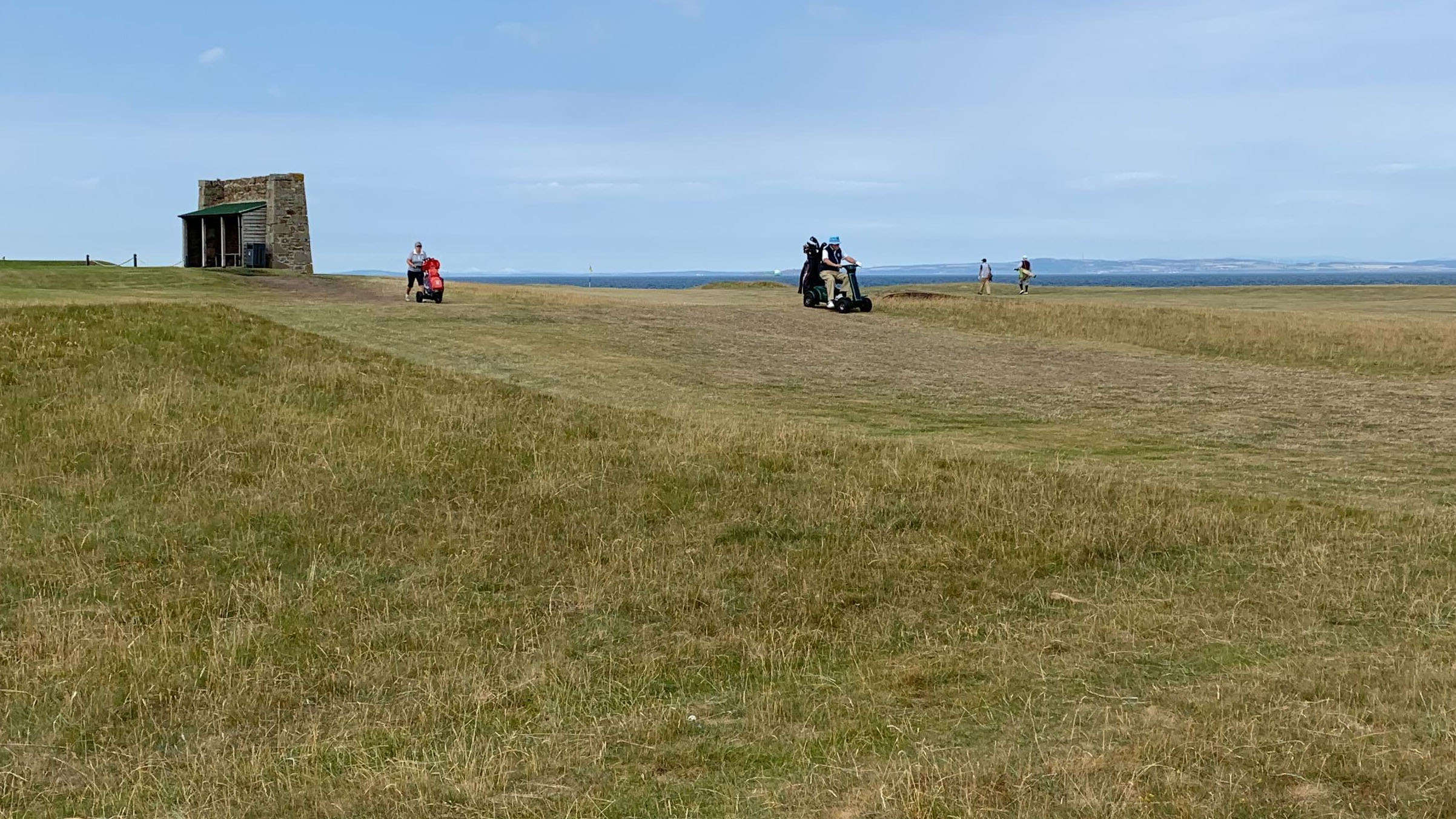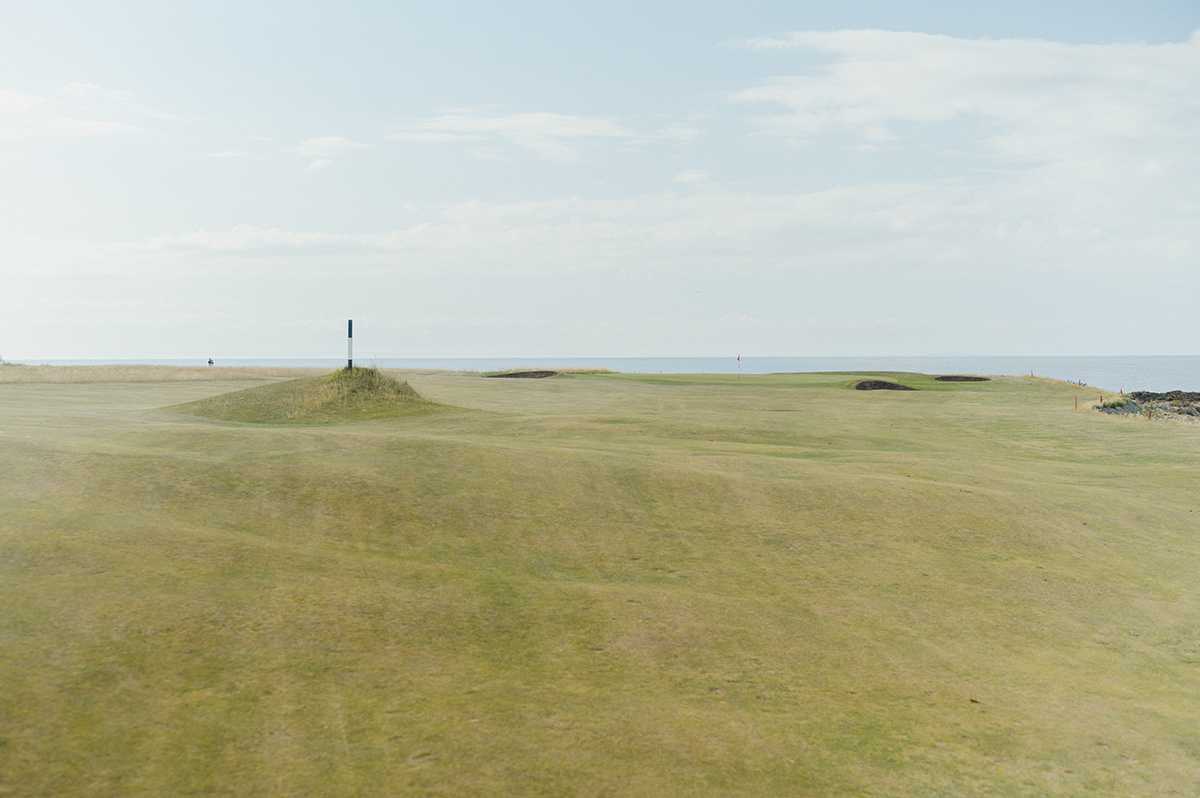No one has as much of a right to declare and define what golf should be and how it should look as the Scottish people, yet they seem to have the least interest in doing so. This hit me as I stood on the fourth hole at Kilspindie Golf Club on Wednesday morning. In one view as I looked out was an elderly gentleman who could not move too well, riding on what could best be described as one of those motorized carts you might use at the grocery store, except he had his golf bag in tow, chugging along, still playing the game. He was playing with a woman, who was walking with a big staff bag on a push cart. Also in the shot was a foursome composed of two older locals and two younger Americans carrying their bags which were full of clubs more than a century old. The diversity of people, tools, transportation, and games hardly resembled each other, but all fell loosely under “golf” on this baked seaside field in East Lothian.

A representative scene at Kilspindie Golf Club. Photo: Brendan Porath
I was with the foursome, which included my colleagues Andy Johnson and Cameron Hurdus, who were taken around the historic links by hickory enthusiast Gordon Shalliday and enthusiast-turned-clubmaker Boris Lietzow. Boris is a bit of a legend in a small hardcore golf subculture, owning a hickory club shop on the main street in nearby Gullane. I’m fairly certain we got about two percent of what sounded like a wild and eclectic life story, but right now, that life seems dedicated to unsuccessful attempts to quit smoking and preaching the gospel of hickory golf. Oh, and also playing hickory golf at a mystifyingly impressive level. The guy hit every trajectory and with the right touch and then made everything. I dabbled with the hickories but was mostly a spectator for this round, and had as much fun watching as any other part of the trip. The hours at the hickory shop are so unpredictable because Boris is often out on the course. After we got around Kilspindie in two hours and 45 minutes, he exclaimed over his whisky and a bummed cigarette from the kitchen that he might go out again. In the middle of the round, he muttered, “I’ve never come out here and thought I’d made a bad decision.” Marching orders for the rest of our golf days.
The variety in my view in that one moment captured the lack of restriction and definition that makes a golf immersion in Scotland so revelatory. It has the history and culture that could get hung up on telling you how to play, or with whom or what clubs, but mostly manages to avoid all that pretension. Of course, there are the many historic linksland courses that have been there centuries promoting a certain style of play, but there are no mandates or requirements. About 15 hours before that revelation at Kilspindie, we were finishing up on the Old Course at St. Andrews just two days after Cameron Smith won the Claret Jug.
The Old Course itself is a paragon of this uncomplicated and unpretentious approach. It’s the most famous course in the world. It’s Tiger’s favorite. The top .01 percent of golf talents can play it in the most meaningful championships, and then a day later the public hacker can competently work his way around it. It was surreal for us—playing in front of those grandstands we’d walked around all week, watching Andy roll in a birdie putt to win a match on the 18th hole—but it was natural for the place, which had turned into a public park with kids frolicking in the Road Hole bunker and strollers parked in the 18th fairway just an hour after Smith putted out for the oldest trophy in golf. It’s hallowed land secure enough in itself to let everyone roam it. Many of the courses are clubs, but costs and accessibility are rarely barriers. As we walked off our last round at Dunbar, a links layout with stunning holes pressed hard up against the sea, we wondered how much it would cost to play in the U.S., or if you’d be able to access it at all.

A view of Dunbar Golf Club. Photo: Cameron Hurdus
Golf is the culture, which I think helps it avoid the dogmatic definitions and constricting insecurities in other parts of the world, especially in the U.S. We went from a major championship venue to Kilspindie, which was par 69 and 5,400 yards. The best shot of the trip was either Cameron’s fairway wood in tight at 14 for a comfy eagle at the Old or Andy’s cleek from 100 yards out at the 18th at Kilspindie that never got more than a couple inches off the ground and finished inside five feet. The variety in par, people, tools, yardages, shot options, and ways to play reaffirmed for me that this is just a game and not an obligation, a recreational pursuit that should be a big tent full of experimentation. Imagine going to the beach for a Saturday recreational day and being told how to spend your time or what to do when you got there. “Welcome to the beach. Today, if you’d like to be here for four hours, you’ll be reading, and this specific book.”
We’ll get into all the particulars of the trip that surrounded the Open, why and how our first visit there charmed us and how it looked with some video and photography. There will also be more on the people—maybe we just got a stroke of good luck in the run of people we played with and hung out with, but they were just as entertaining and memorable as the courses. We’ll be trying our best at poor impersonations of a few of their accents and cheery cadences for years. But for me, one of the takeaways that will persist from the trip will be the feeling of arriving at a golf course with minimal preconceived expectations, aside from the expectation of variety in who and what I would see and how I would see it played. I hope that continues back in the States, but I’m doubtful.
Tom Doak once wrote that Pete Dye told him, “Everything in golf is a matter of opinion,” adding, “There’s no right way to grow grass; there’s no right way to swing a club; and there’s no right way to design or build a golf course.” Scotland promotes experimentation and expression of a wider variety of those opinions. The lack of definition and direction is accepted as part of the game, with centuries of evidence for support.


 by
by 
